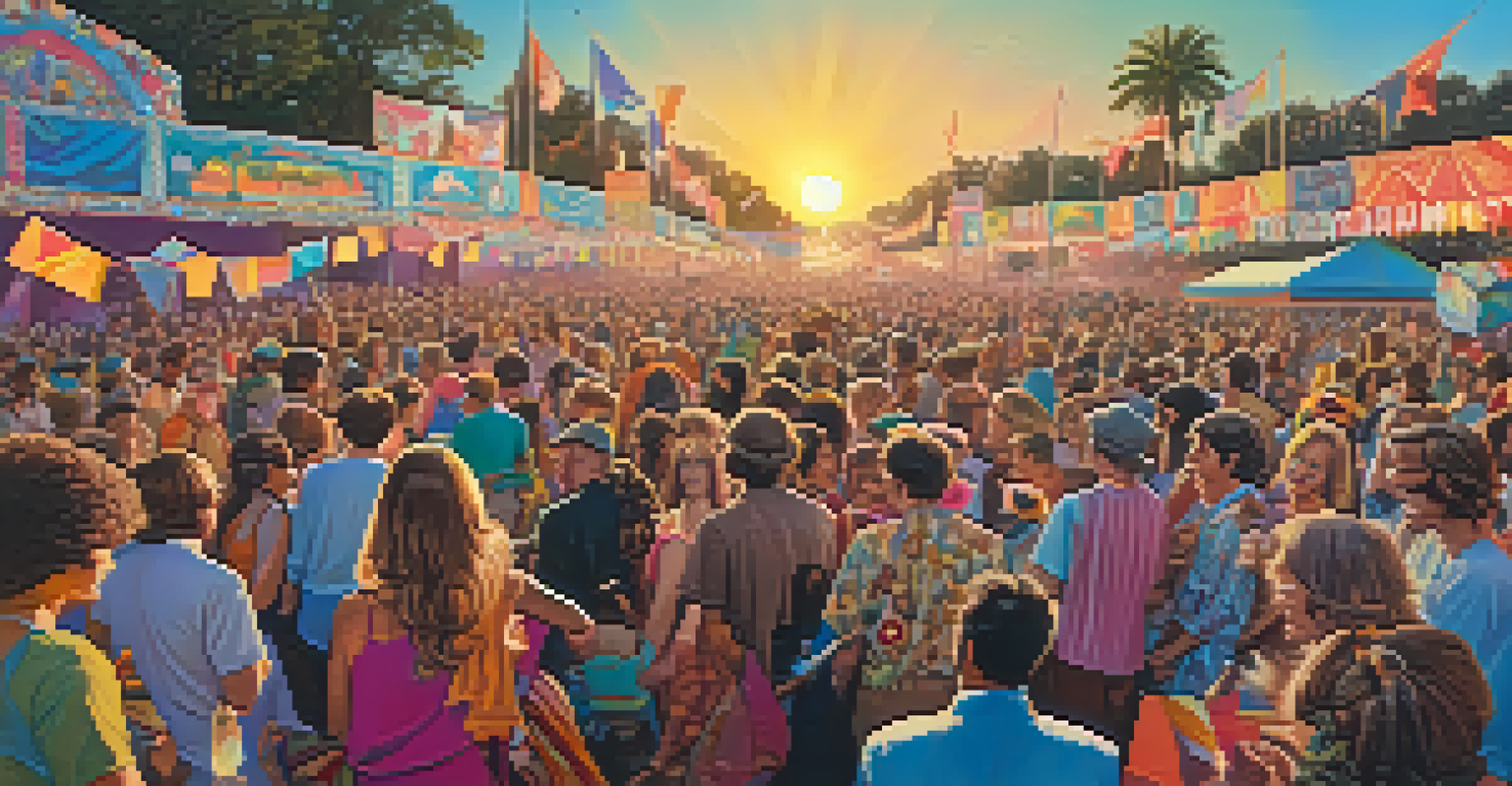Psychedelic Rock: Sounds of the 60s and Their Legacy Today

The Birth of Psychedelic Rock in the 1960s
Psychedelic rock emerged in the mid-1960s, primarily in the United States and the UK, as artists experimented with new sounds and themes. Bands like The Beatles and The Byrds began incorporating unconventional instruments and studio techniques, setting the stage for this vibrant genre. This musical movement was heavily influenced by the counterculture of the time, including the rise of the hippie movement and the exploration of altered states of consciousness.
The music is a reflection of the time and place, a soundtrack to the social upheaval that defined a generation.
Songs often featured surreal lyrics, extended instrumental solos, and innovative sound effects, which transported listeners to a dreamlike state. For example, The Beatles' 'Lucy in the Sky with Diamonds' exemplified this style with its whimsical imagery and intricate soundscapes. As artists pushed boundaries, psychedelic rock became a canvas for self-expression and social commentary, reflecting the era's cultural upheaval.
The genre quickly gained traction, with bands like Jefferson Airplane and The Doors adding their unique spins. The Summer of Love in 1967 marked a peak in psychedelic rock's popularity, as music festivals and concerts celebrated peace and love. This movement not only transformed music but also influenced art, literature, and fashion, creating a lasting cultural legacy.
Key Characteristics of Psychedelic Rock
Psychedelic rock is defined by its distinctive sound, which blends rock elements with experimental styles. One hallmark is the use of reverb, echo, and other sound effects that create a sense of depth and dimension. Additionally, unconventional song structures and rhythms challenge traditional rock formats, inviting listeners to experience music in a new way.

Instrumentation often includes non-traditional elements like sitars, flutes, and synthesizers, which add to the genre's unique flavor. For instance, George Harrison's use of the sitar in 'Within You Without You' showcases how these instruments can expand musical boundaries. Lyrics often draw upon themes of consciousness, spirituality, and the natural world, reflecting the era's fascination with self-discovery.
Psychedelic Rock's Cultural Impact
Psychedelic rock became a cultural phenomenon that promoted ideals of peace and social change, influencing art, fashion, and societal attitudes.
The visual aspect of psychedelic rock is equally important, with vibrant album art and elaborate stage shows enhancing the overall experience. Iconic album covers, such as Pink Floyd's 'The Dark Side of the Moon,' feature bold colors and abstract designs that mirror the music's surreal qualities. This fusion of sound and visual artistry has left an indelible mark on the music industry.
Influential Bands and Albums from the Era
Several bands played pivotal roles in shaping the psychedelic rock landscape, with The Beatles often hailed as the genre's pioneers. Their albums 'Revolver' and 'Sgt. Pepper's Lonely Hearts Club Band' are considered masterpieces that redefined popular music. These works pushed the boundaries of studio recording and songwriting, inspiring countless artists to explore new creative avenues.
Psychedelic music is about exploring the mind, connecting with the universe, and experiencing life in a new way.
Other notable bands like The Grateful Dead and Cream brought their unique styles to the forefront, contributing to the genre's diversity. The Grateful Dead's improvisational approach and extended jams created a live music culture that endures to this day. Cream's fusion of blues and psychedelia, as showcased in 'Disraeli Gears,' demonstrated the genre's versatility and appeal.
In addition to these giants, groups like The Velvet Underground and Jefferson Airplane introduced darker and more experimental elements. Their music challenged societal norms and explored themes of love, loss, and existentialism. Together, these bands crafted a rich tapestry of sounds that continues to resonate with listeners and influence contemporary music.
The Cultural Impact of Psychedelic Rock
Psychedelic rock was more than just a musical genre; it became a cultural phenomenon that influenced art, fashion, and societal attitudes. The music often served as a soundtrack for the counterculture movement, promoting ideals of peace, love, and social change. Events like Woodstock in 1969 epitomized this spirit, bringing together thousands of people to celebrate music and unity.
Artists and musicians began to challenge the status quo, using their platforms to advocate for civil rights, environmentalism, and anti-war sentiments. Songs like Buffalo Springfield's 'For What It's Worth' captured the essence of this activism, resonating with a generation seeking change. The genre's emphasis on freedom of expression and exploration of consciousness inspired many to question societal norms.
Evolution into Modern Genres
The genre evolved in the 1970s, leading to the emergence of progressive rock and heavy metal while still inspiring contemporary artists across various styles.
Moreover, psychedelic art and fashion flourished alongside the music, with vibrant colors and intricate patterns becoming symbols of the era. Designers and artists embraced the psychedelic aesthetic, creating a visual language that complemented the sounds of the time. This cultural synergy helped solidify psychedelic rock's place in history as a movement that transcended music, influencing various aspects of life.
The Evolution of Psychedelic Rock in the 70s and Beyond
As the 1970s rolled in, psychedelic rock began to evolve, giving way to new genres like progressive rock and heavy metal. Bands like Pink Floyd took the psychedelic elements of their earlier work and expanded them into more complex compositions. This shift marked a transition from the carefree vibes of the 60s to a more introspective and sometimes darker exploration of themes.
Despite these changes, the spirit of psychedelic rock never truly faded away. Artists continued to draw inspiration from the genre, incorporating its elements into their music. For example, the alternative rock movement of the 80s and 90s saw bands like The Smashing Pumpkins and Tame Impala resurrecting those dreamy soundscapes and experimental approaches.
Moreover, modern artists have embraced psychedelic rock's legacy, blending it with contemporary styles to create a unique sound. From indie rock to electronic music, the influence of psychedelic rock can be heard in the works of artists like MGMT and Pond. This ongoing evolution highlights the genre's enduring appeal and its ability to resonate with new generations of listeners.
Psychedelic Rock Today: A Resurgence of Interest
In recent years, there has been a notable resurgence of interest in psychedelic rock, as both new and established artists explore its rich sound. Festivals and concerts dedicated to the genre have gained popularity, celebrating its timeless appeal. Events like Desert Daze and Levitation highlight the continued relevance of psychedelic music in today's cultural landscape.
Streaming platforms have also played a crucial role in reintroducing psychedelic rock to a broader audience. Playlists featuring classic tracks alongside contemporary artists have made it easier for fans to discover and enjoy the genre's evolution. This accessibility has sparked a renewed appreciation for the sounds of the 60s and their influence on modern music.
Resurgence of Psychedelic Interest
Recent years have seen a resurgence of interest in psychedelic rock, with festivals and streaming platforms reintroducing its rich sound to new audiences.
Additionally, collaborations between artists from different genres have further blurred the lines, creating fresh interpretations of psychedelic rock. The fusion of electronic music with traditional rock elements has led to innovative sounds that pay homage to the past while exploring new frontiers. This dynamic blend showcases how psychedelic rock continues to inspire and evolve.
The Legacy of Psychedelic Rock in Modern Music
The legacy of psychedelic rock is evident in the music of today, with many artists citing it as a major influence. Genres like neo-psychedelia and dream pop have emerged, showcasing the enduring appeal of those lush, expansive soundscapes. Bands such as The Flaming Lips and Animal Collective have embraced this style, creating music that feels both nostalgic and fresh.
Moreover, the themes explored in psychedelic rock—such as consciousness, nature, and existentialism—are still relevant to contemporary audiences. Many modern songs reflect a similar sense of wonder and introspection, encouraging listeners to embark on their own journeys of self-discovery. This thematic continuity underscores the timeless nature of the genre's messages.

As we look ahead, it's clear that psychedelic rock will continue to inspire future generations of musicians and listeners alike. Its ability to evoke emotions and challenge perceptions ensures that its influence will remain a vital part of the musical landscape. Ultimately, psychedelic rock has carved out a lasting legacy that resonates across time, reminding us of the power of sound and imagination.